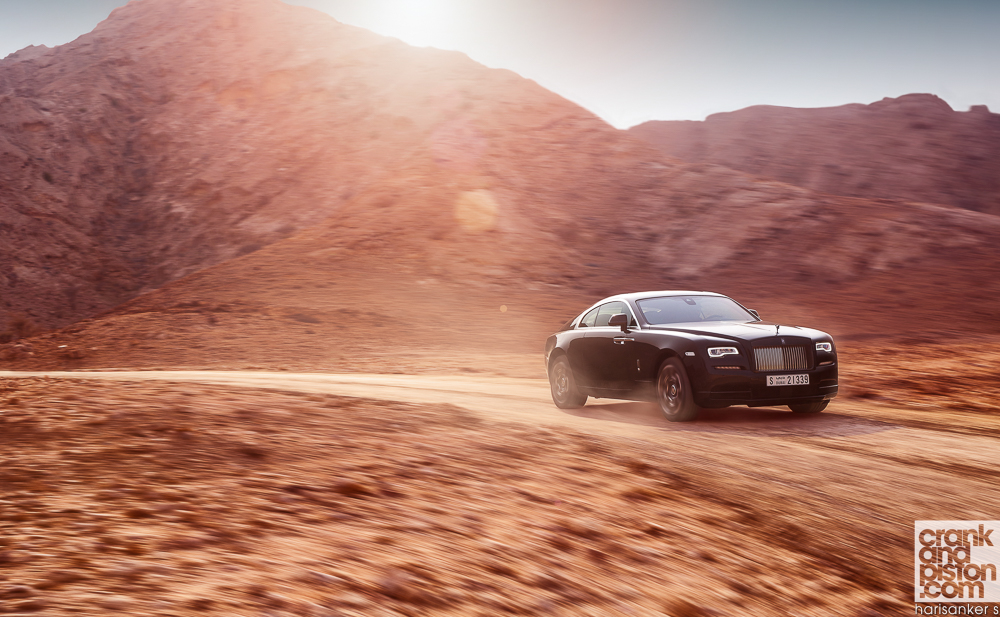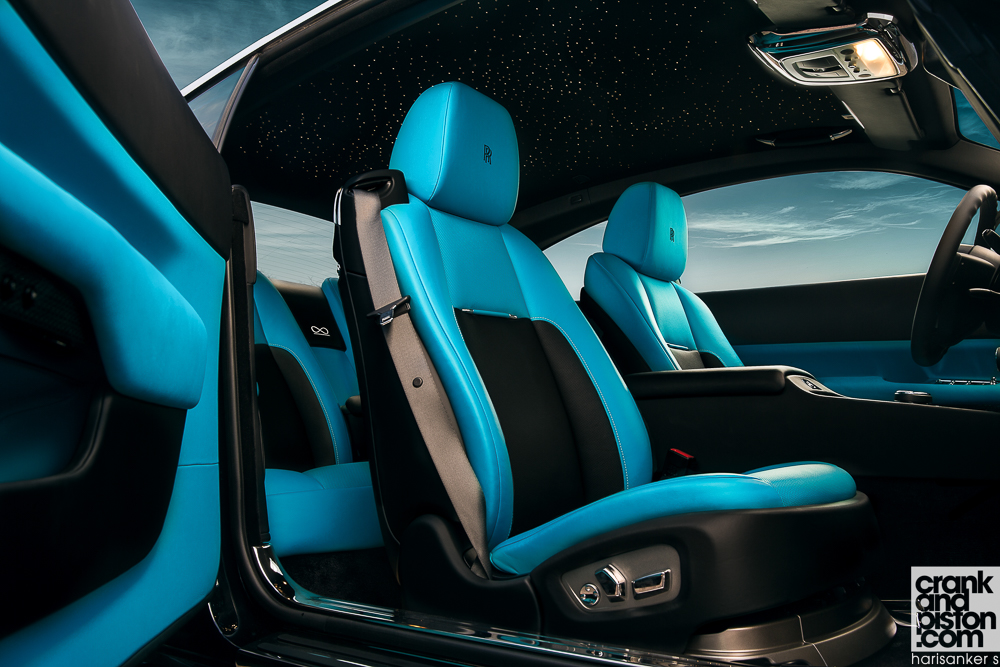Behind the drive. Rolls-Royce’s ‘Black Badge’
Feature | crankandpiston.com / EVO Middle East
Ahead of our first drive of the Wraith Black Badge in Las Vegas, James takes an in-depth look at, possibly, the most radical Rolls-Royce yet…
Originally posted – 5 September, 2016 | crankandpiston.com | EVO Middle East magazine
It’s clear from the get-go that Jamal, who joins us today from Rolls-Royce, is feeling twitchy. For starters, the actual first drive of the new Wraith Black Badge we’re shooting today will only take place a few days from now 12,000km away in Las Vegas. Though Jamal is happy to walk us through the ins and outs of the newboy, he’s very keen to make sure that impressions of the drive are not part of today’s schedule. Cue overly dramatic sigh from yours truly.
It’s more than that though. Given the expectation weighted on the new ‘Black Badge’ range – beaten only by the 2017 Cullinan SUV – it’s a twitchiness that stretches all the way back to company headquarters in Goodwood. The Black Badge after all targets a younger audience for Rolls-Royce in line with the falling average age of its customers, whilst at the same time avoiding alienating its established owners.
More significantly even than that, the Wraith Black Badge is probably the closest Rolls-Royce is ever likely to come to a performance model.
“You could say we’re transforming one of our icons and giving it a darker edge,” Jamal explains, already loosening his tie as the Middle Eastern heat begins to knock the breath from our lungs. “On the surface the Black Badge is definitively a Rolls-Royce. But underneath? It’s a very different beast.”
It’s a description remarkably similar to the official marketing material, in which Rolls-Royce underlines the ‘restless spirit’ and ‘more assertive, confident and demanding aesthetic’ – blah blah blah – of both the Black Badge and its ‘new breed of customers.’ Wade through the exhausting hyperbole though and there are some salient points. For starters, the Black Badge is no one-off, Rolls-Royce having already confirmed a ‘permanent bespoke series’ akin to Mercedes’ Maybach sub-brand (though only the Wraith and short-wheelbase Ghost will receive the Black Badge treatment). And though the company refrains from using words like ‘performance’ and ‘speed’, one very un-Rolls-Royce term – ‘powerful’ – is repeatedly uttered in barely hushed tones.
The Wraith’s 6.6-litre twin-turbo V12 remains intact with, ironically, the same 624bhp power figure as before. Torque meanwhile has been upped from 590lb ft to 642lb ft for a ‘uniquely discernible extra edge’ (but don’t bother asking for 0-100kph times or a top speed). Similarly the uprated eight-speed automatic gearbox is largely untouched, although RR’s engineers have implemented what they call ‘intuitive throttle response’ into its configuration. Use more than 25 per cent throttle and the gears are held between 200rpm and 500rpm longer for added grunt. Between 70 and 80 per cent of throttle, the transmission is remapped for speedier changes, and should you be suitably unsavoury to use 80 and 100 per cent of the throttle, the V12 revs through to 6000rpm. Even under deceleration, the transmission will downshift a few rpm sooner to heighten engine braking for more composed corner entry.
It’s minute stuff, admittedly, since Rolls-Royce has no intention of negatively impacting its core luxury values. Nevertheless, it does indeed show a darker side (forgive me) than we’ve seen from Rolls-Royce hitherto. Even the air-suspension has been completely redesigned for more ‘driver-focused’ agility: had any Rolls-Royce engineer suggested such a thing even five years ago, it was with resignation letter in-hand.
Aesthetically though is where the Black Badge really sets itself apart from the standard Wraith, as Jamal, now rolling up his sleeves, takes great delight in showing me. The use of dark chrome – meticulously machined, of course – is one of the bigger design addendums, detailing the front grille surround, boot lid finisher, lower air inlet finisher and exhaust pipes as it does. Traditional features like the pantheon front grille and the Spirit of Ecstasy remain unchanged in both design and material, but are clad in an edgier shade of black or dark silver. And if this sounds like small potatoes, bear in mind that RR doesn’t take such decisions lightly. It’s the first ‘radical’ step since Sir Henry Royce changed the traditional red-on-silver double R logo to black-on-silver. In 1933. And even this took weeks to approve.
An appropriately ‘intense’, hand-polished black adorns the Black Badge bodywork, the deepest yet on a production Rolls-Royce. A theme that continues across the lightweight alloy wheels (which retain the self-levelling Rolls-Royce emblem in a particularly neat touch) and into the cabin. The air vents front and rear are darker than normal, ditto the starlight headliner on the roof, and even the infinity logo on the rear seats – denoting a ‘daring’ attitude – is stitched in deep black. It’s an impressive look, and yet I can’t help but comment to Jamal that, perhaps, the very-blue interior knocks this ‘dark theme’ just a tad. Riposte already loaded in the chamber, he’s quick to point out Rolls-Royce’s vast options list, though refrains from mentioning how much this adds on top of the $365K you’re already forking over (some $45K up on the Wraith itself).
Mounted on the dash is a bespoke ‘Black Badge’ clock with orange-tipped hands, while the – deep breath – aerospace-grade aluminium-threaded carbon fibre composite surfacing is a material often used on stealth aircraft, and weaves aluminium just 0.014mm in diameter together with carbon fibre before SIX layers of lacquer are applied. It’s painstaking work, confirmation if it were needed that ‘luxury’ on a Black Badge takes precedence over ‘spirited driving’.
Speaking of which…
Six months later.
The grittier, edgier Black Badge treatment is applied to the Rolls-Royce Ghost. But does Goodwood’s flagship limousine really lend itself to this ‘restless spirit’? James is not convinced…
Originally posted – 12 March, 2017 | crankandpiston.com | EVO Middle East magazine
Fans of Rolls-Royce will know the luxury brand has never shied away from hyperbole when launching a new model. Marketing and press materials alike are traditionally awash with terms such as ‘bespoke, ‘authentic luxury’, and, the old classic, ‘uncompromised’. With the new Black Badge series, it’s no different, given that Rolls-Royce are keen to emphasise the ‘defiance’ and ‘restless spirit’ of its select owners that dare to take on a darker and edgier lifestyle of, ahem, luxury motoring.
Nauseating yes, but almost – almost – forgivable. The reasoning behind the Black Badge series after all was not to promote a new, ‘sporting’ Rolls-Royce – such terminology leads to 20 lashings in Goodwood – but a grittier, more youthfully orientated model line in the hopes of attracting a newer, funkier clientele without alienating the company’s existing, more established customer base (it was also a way of making third-party tuners look less enticing, though Rolls-Royce will never officially admit that). And with the Wraith Black Badge we tested last year, easily the most [cough] dynamic [cough] model on the range, it was easy to lose oneself in this philosophy and applaud the new Black Badge as a success.
But with the Ghost Black Badge, I’m less convinced.
To be fair, the Black Badge styling remains the same across both the Wraith and the Ghost. The deep, resonating black paint on our test model is lacquered and polished repeatedly – again, uncompromised – to create the darkest paint ever seen on a production Rolls-Royce. The Spirit of Ecstasy on the nose and the Double R badges on the flanks have gone from silver to black, a bigger deal than that might seem on the surface given how protected both symbols are, particularly the former that first appeared in 1910. Even the new composite carbon fibre 20in wheels are Black Badge ‘bespoke’ (ahem) and were developed across four years. The cabin meanwhile receives the same Black Badge nuances, including dual tone red leather, an ‘Unlimited’ infinity logo embroidered on the rear upholstery and unique orange-tipped hands on the dashboard clock. On the Wraith, the most dynamic production Rolls-Royce in history, this new ‘edge’ leant itself admirably to a demographic of young entrepreneurs with bulging wallets.
With the more refined Ghost, however, I can’t help but wonder if the Black Badge treatment has lost its shine. The looks of the Ghost for instance are striking enough already, both upon the model’s initial release in 2009 and its 2014 facelift, whereby thinner LED headlights were added, the front grille was raised 30mm, and grooves were added to the bonnet a la vapour trails from the Spirit of Ecstasy. Even without the Black Badge tinsel, the Ghost remained a strong, aggressive look for Rolls-Royce, a presence made even greater, and certainly more significant, now that production of the Phantom has ended. In all honesty, did Rolls-Royce’s new flagship limousine really need to become ‘a creature of the night’ to heighten sales?
Perhaps then the answer lies in the drive, and admittedly, there is little to criticise the limousine in this regard. The 6.6-litre twin-turbo V12 – formerly the 5972cc unit you’d find in the BMW 7 Series – has received the smallest of performance peps, power now increasing 40bhp to 603bhp and torque up from 44lb ft to a weighty 620lb ft. Such a ghastly notion as 0-100kph times is beyond a Rolls-Royce owner, naturally, but rest assured, when given a bootful, the Ghost Black Badge will run door handle to door handle with an Aston Martin Rapide S.
The enormous bank of torque kicks in from a lowly 1650rpm, meaning the initial surge of acceleration is enormous. Smooth rather than aggressive, yes, but never laboured, and you get the impression there’s far more to come from the V12 were Rolls-Royce to fully let it off the leash. As part of the Black Badge treatment, and when the pedal is pushed a quarter way towards the thick lambswool carpeting, the revs are held for between 200 and 500rpm longer than usual, meaning acceleration is considerably more spirited: from the mercifully untouched ‘authority’ driving position, you’ll even see that huge bonnet nod towards the heavens under acceleration.
This heightened dynamism though has done little to dent the Double R’s luxury. The ride is sumptuous with only the most rutted of potholes making a dent in the ride quality. At full chat, little V12 warble manages to scythe through the intense sound deadening. Visibility, one rather thin rear window aside, is impressive all-round, and both the build and material quality are second to none. The steering has been very subtly tweaked to increase driver focus, and while there’s a degree of weight that dials in as speed increases, there’s very little feedback as you would expect (at low speeds and full lock, it’s like piloting an ocean liner).
There is a degree of body roll – again, as expected for a limousine – but not quite as much as you’d reasonably expect, BMW-derived anti roll bars managing to hide that mighty 2,490kg girth impressively well. Clearly Rolls-Royce has not forgotten its new flagship is all about comfort and refinement, which makes it all the more difficult to justify the additional edge and ‘drama’ of the Black Badge grit, for this particular writer at least.
And again, that’s got me wondering if the Black Badge edition Ghost truly makes the impact its creators had hoped it would. Yes, on the more dynamic Wraith, the grittier, more visceral drama does lend itself to an already sporting drive. But with the Ghost, it’s difficult to ever really forget that you’re driving something other than a fast, superbly comfortable limousine, that just happens to have black paint, unique wheels and a couple of extra thousand attached to that already hefty asking price. Then again, that might just be my defiance and restless spirit breaking through…
Images | Awesome Group and Harisanker S
Feature | crankandpiston.com / EVO Middle East | James Gent



















